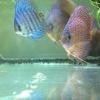Gravel
#1

Posted 20 May 2016 - 09:22 PM
I have a 210ltr tank and have high nitrate level around 10ppm.
I feed my cichlids every second day and check for any leftovers ( not usually as they're quite hungry) I do a 10% water change every 2nd day, with 30% once a week including vacuum of gravel. I have nitrate pad in the filter and change every 3 weeks. The cichlids are all doing well. I do have about 2 inches of gravel, so wondering if this is too much for the tank.
Look forward to feedback
Thank you
#3

Posted 21 May 2016 - 07:34 AM
New water has a composition that makes fish feel temporarily uncomfortable,,,, but once the new water is oxygenated and mixed in with old,, it tends to neutralize a bit but mostly dilute till the more long term changes take place in chemical composition form.
Weekly water changes of 30-40% is a better balanced regime and stimulating for the fish.
As for the gravel, yep, way to thick,,, only 15mm is best,,, you don't want a waiste trap that generates nitrates.
- Lesa1966 likes this
#4

Posted 21 May 2016 - 12:01 PM
Get rid of the gravel and go for something finer about 1mm that's heavy enough not to be stirred up and stay suspended. Then any waste can't get trapped in the substrate and stays on top for cleaning either by the filter or when you do a water change.
#5

Posted 22 May 2016 - 08:29 AM
#6

Posted 22 May 2016 - 01:51 PM
be careful of removing too much gravel at once , as the gravel often has heaps of food trapped in it as well as containing a lot of good bacteria that is actually filtering the water in a sense . Removing it all at once can cause an ammonia spike that you don't want. Have had it happen to a tank of mine very early on and certainly wont be doing that again
#7

Posted 23 May 2016 - 12:05 AM
Beneficial bacteria are our primary friends yes, because perform the task of the nitrogen process/cycle.
The beneficial bacteria (bb), do live on all surface areas, and is beneficial in areas that can pass by to be treated in a turn over sense.
To remove all media at once will not cause any bb shock or crash.
Your filters are designed specifically with increased surface areas to house bb, and if you have sufficient filtration or better, it then should not be of any concern.
Just keep your KH and temperature up in times of stress like gravel removal,,, keep their immune systems up.
Never the less,,, I could see a ameture mistake, leaving filter running and scooping gravel and releasing crap and clogging filters in one go and not knowing.
That filters blocked with water not passing through fast enough,,, only needs 4 hours plus and issues arise.
If your good at cleaning filters with minimal bb disruption, then allow filter to run and suck crap up , once water has roughly cleared, then clean your filters immediately,,,,,,,
Otherwise, turn your filters off and back on once job is done....
#8

Posted 23 May 2016 - 12:41 AM
agree with someone and disagree with someone else....
anaerobic bacteria will thrive in good depths of gravel... they will actually break down nitrates into n2 gas... ever noticed while gravel cleaning you release bubbles that goto the surface and are released into the air ???
i had a tank with 2 inches of gravel also harbouring 100's maybe 1000's of b/n and its nitrate level didnt really rise as a similar tank with only 1 inch of gravel did... both tanks received 50% water changes weekly....
tanks with gravel in - i have never had any type of bad bacterial infections....
glass bottom tanks - i cant say the same for - have lost some irreplaceable fish unfortunately...
if your going glass bottom you need to seriously make sure your filtration is more than adequate for your tank plus some and be very careful when cleaning / maintaining filtration... no real room for error..... gravel bottomed tanks harbour lots of good bacterias and give you more bacteria... so if you overclean your filter and remove too much beneficial bacteria you still have a good amount of beneficial bacteria in gravel that will help consume your upcoming ammonia spike and may well cushion it completely...
if your running big setups plumbed together with sumps then removing gravel from one tank wont be an issue as buccal suggested.... but if its a single tank with its own filtration and you remove all the gravel then you could have issues depleting existing bacteria in the gravel....
especially if you have 2 inches of it.....
#9

Posted 23 May 2016 - 07:46 AM
So I very strongly strongly disagree with you Johnno.....
I see some breeders with those little black sponge airlift filters,,, I know they are economical and many people rave about them, but they put you on the edge of being juuuuuust enough filtration with the extra 2-5% extra advantage of beneficial bacteria living in substrate.
Disrupt that fine line and you got issues.
For any beneficial type bacterias to serve any gain,,, the water (even super slow works) must pass through the area of beneficial bacteria then come out as being treated.
This water transference does not happen in this way or flow through enough unless under gravel filters are used but ammonia and nitrite loving bacterias will take over instead like a normal filter
It's very rare for most people to encounter nitrate eating bacteria, little lone get it working for them.
9 times out of 10, long time thick substrate will cause issues of nitrate rising and bad bacterias.
1 time out of 80, you may strike a happy medium for SOME nitrate eating bacteria and I think that 1/80 is being a bit generous.
I'm 40 and only had a centrifuge sump breed room and serious breeding for last 8 years,,,, all before that, I always ran seperate canisters and was always whipping out my substrates or replacing with no ill effect ever I'm I mean ever.
I just never fed fish next to days after any big change........ I'm seeing to much rocket science these days..........
Edited by Buccal, 23 May 2016 - 07:48 AM.
#10

Posted 23 May 2016 - 07:56 AM
The way a tank generates waste and filters relationship.
A person with a stocked up tank full of cichlids that eat a lot and grow big and fast.
Is way different to :
A person with a lightly stocked tank with a few L numbers or minimal food eating fish like guppys.
Big heavy stocked up loads, require filtration that can handle sudden rise impact.
I don't consider it safe fish keeping to rely on any part of the beneficial bacterias living in and on the substrate.
Even well balanced out Cichlid tanks.
To me, all of this isn't one bit debatable.
Edited by Buccal, 23 May 2016 - 07:58 AM.
#11

Posted 23 May 2016 - 08:42 AM
#12

Posted 24 May 2016 - 12:53 AM
not sure how you work out 1 in 80 - but i must be it ![]()
you should know me - lots of fish - lots of water changes - lots of food - no stopping the machine.... any significant disruption to beneficial bacteria will be an issue...
i still think you will be surprised at just how much beneficial bacteria survives in gravel beds - and a well maintained gravel bed is beneficial.....
the only times i have had columnarus or similar gram negative bacteria problems is with glass bottoms.... i still have some glass bottoms but to be honest its not my perfect scenario.... glass bottoms if not managed can harbour a slimey film that tiny bristlenose fry go ass up if they eat it... doesnt seem to bother adults though...
I wasn't referring to the way I run things with my sump,,,,,, it's pretty basic and most are going to agree with me,,,,,,, a fish tank a lone connected to the right size filters do not rely on their substrate for any part of the needed nitrogen cycle.
making the assumption the tank is over filtered with media to the ratio of bioload being produced... if the load is greater then the filter can manage and gravel substrate picks up the difference - if you suddenly remove this gravel you will have a problem - you cant argue with that - thats common sense... each individual tank and setup can be different.... a lot of people run their tanks/filtration close to the tipping point without knowing...
eg) 6x2x2 with couple goldfish and running a large eheim cannister - should not experience any problems removing gravel substrate...
eg) 6x2x2 with 1000 bristlenose running that same large eheim cannister - you will prob experience problems removing gravel substrate...
this is not theoretical assumption but something i have seen firsthand - and ammonia/nitrite/nitrate tests done correctly do not lie....
i understand your statement and theory also - in the perfect world - but you have to realise general hobbyist dont do things perfectly - more often than not $$$ makes compromises in fish keeping...
- Chopstick_mike likes this
#13

Posted 24 May 2016 - 05:03 AM
Never made a assumption on any tank being over filtered.
Surely when I gave the figure of 1/80 you must have known it was rough guess to paint some sort of picture and give idea on how extreme the situation is.
If you've pulled out substrate and had a crash with ammo spikes,,, your likely running sponges and being very close to underfiltered or just straight out under filtered.
If filters are cleaned two weeks prior to substrate removal, and feeding stopped for two days after substrate removal,,,,,,, and beneficial bacteria population issues occur after taking out substrate,,,,, then I'm sorry to say the tank is under filtered.
If water transference inside gravel to outer water column isn't happing like in nearly all cases excluding undergravel filters,,, then the beneficial bacterias in substrate isn't helping but trapping.
Using substrate as a filter media with undergravel filters use to be very economic popular,,,, but the issues of waste and disease was a very common and clear problem,,,,, since then technology has bought forward much better ways to filter.
It's very hard to find undergravel filters in most shops these days.
L numbers don't have the metabolisms like active moving cichlids,,, L's food requirements and rate of water pollution is usually 1/3 to a cichlids habits.
Plus low KH can have a impact on beneficial bacteria over all populations to begin with also.
#14

Posted 24 May 2016 - 08:38 AM
I dont use them because they're cheap, I use them because they are ridiculously efficient, versatile and easy to clean. Stick a power head on top and you have a 2000l/h bio and mechanical filter.
- chocky and Chopstick_mike like this
#15

Posted 24 May 2016 - 01:19 PM
The power head driven sponge filters I agree,,, they are the bomb,,,, I have them in the biggest sizes you can get all as additional filtration all through my ray systems and all my pup growouts.
I rate them better than canister filters as far as the way they work goes.
#16

Posted 24 May 2016 - 04:40 PM
I use airlift sponges to great effect. They are very cheap in capital and operation, easy to install and make fantastic feeding platforms for fry.
These principles about waste and bio-load depend on your perspective. You say underfiltered - I say overstocked.
The way I have always viewed it is that essentially you need three things to have effective biological filtration:
1. food for the bacteria (ammonia and nitrite)
2. oxygen (consumed from the water column in nitrification)
3. surface area for bacteria to colonise. It can be gravel or filter media or sponges or the glass. You just need a steady water flow past it to be effective.
The total amount of nitrification in your tank at any given time will be limited by one of these factors. A well designed tank will ensure that food is always the limiting factor. When it's oxygen or surface area limiting the amount of nitrification then you run into big problems.
That's the basic principle without spurting chemical formulas and there are a million ways you can alter a tank setup to abide by it. If you achieve this principle relying on gravel then that's fine. If you achieve it by relying on massive pumps and huge beds of media then that's fine also. But to say one method is wrong even if it's achieving this basic principle suggests the science isn't well understood. That's fine also - it's how they sell massive canister filters for $1000 a pop.
- chocky likes this
#17

Posted 24 May 2016 - 08:23 PM
But because water contact time is needed, being airlift water driven device,,, airlift sponge filters tend to process the water at a slow to moderate rate at best,, I believe the purpose is defeated when 2 or 3 more sponges are added.
Using airlift sponges one must really play by the rules for stocking and so on.
But the main debate was substrate being to thick causing it to be a nitrate trap.
And was said that the balanced nitrogen cycle in a aquarium depends greatly on substrate housing beneficial bacteria.
My guess would be that beneficial bacteria living on and in substrate contribute roughly 2-10% to total nitrification in a tank,, and 10% I think is being a bit generous.
#18

Posted 24 May 2016 - 09:08 PM
Edited by Chopstick_mike, 24 May 2016 - 09:08 PM.
#19

Posted 24 May 2016 - 09:58 PM
The amount of nitrification in filters vs gravel will be dependent on your setup. If the food/waste is getting into the gravel layer then the bacteria there are the ones that will consume it. If it's getting sucked into your canister then that's where most of the nitrification will happen. The size of the grain is important because there will be less volume of water in between the grains of sand than there will be gravel. Because there's less water in sand substrates then there will also be less oxygen. So nitrification is limited in those zones by a lack of oxygen. When you run out of oxygen then anaerobic conditions form and in these reactions you get more noxious compounds forming as opposed to nitrate.
I've run tanks successfully for years with thick beds of sand. They used to bubble off nitrogen from time to time when you pass a gravel vac through but I never encountered problems with water quality. I relied on an airlift filter (not sponge) to nitrifying most of the waste and because of driving filtration with air, I believe I always had saturated oxygen levels and anaerobic conditions weren't able to form. Some marine guys use deep fluidised sand beds as their primary source of filtration in reef tanks and some of those principles can be transferred to freshwater.
I'm a big advocate of air driven filters though as I think DO is the most overlooked water parameter by most aquarists and a lack of it causes the most problems in people's tanks. It's probably the easiest water parameter to fix if you have a deficiency too. But if you're trying to squeeze the maximum bio-load into the smallest volume of water, then yes you will need to get a big mutha pump and a heap of extremely porous filter media to pump the water through.
#20

Posted 25 May 2016 - 02:14 AM
no doubt i have had anaerobic bacteria in deep beds of gravel - n2 gas is bubbled out when you do a deep gravel clean... and this particular tank (chockas of bn) never had any issues with rising ammonia or nitrate - even after cleaning the sole cannister filter.... few times even cleaned a tray in tap water to get all the crap off it... i did a bit of google about gravel depths and the google machine says different types of bacterias exist in your gravel bed as you get deeper.... and using 3mm grain size or larger does actually see some water flow getting into the gravel to certain depths... obviously the deeper you go less water/oxygen goes... given hold to anaerobic bacteria forming in the lower depths of gravel
0 user(s) are reading this topic
0 members, 0 guests, 0 anonymous users













